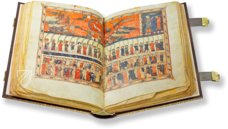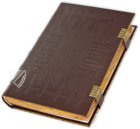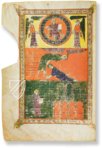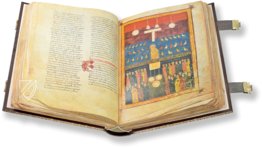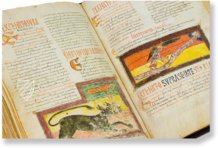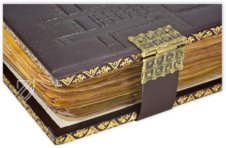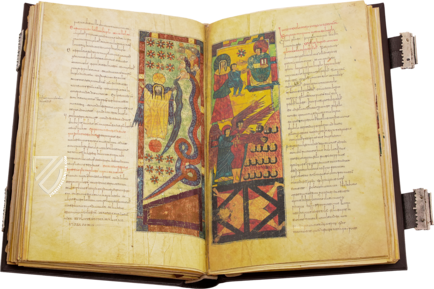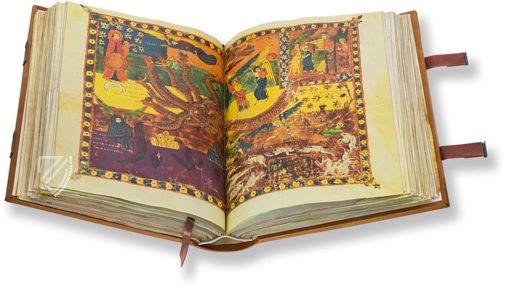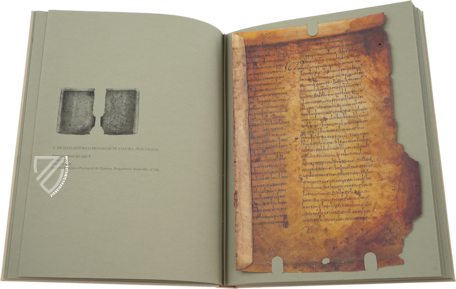Beatus of Liébana - Codex Urgellensis
(3,000€ - 7,000€)
One of the most beautiful Beatus manuscripts of the 10th century is stored in the diocese museum of the Cathedral of La Seu d’Urgell in northernmost Spain. The codex contains the famous apocalypse commentary of Beatus of Liébana concerning the Book of Revelation, which has been transmitted in numerous wonderful and richly illustrated manuscripts. The miniatures of the Codex Urgellensis with their exceptional creativity and outstanding quality identify the anonymous artist as a true master of illumination. Thus, in the combination of the haunting and mysterious biblical text and the commentary of the Asturian monk with the marvelous miniatures, the codex constitutes one of the most beautiful specimens among the consistently high-quality northern Spanish manuscripts.
Beatus of Liébana - Codex Urgellensis
One of the most beautiful Beatus manuscripts of the 10th century is stored in the diocese museum of the Cathedral of La Seu d’Urgell in northernmost Spain. The codex contains the famous apocalypse commentary of Beatus of Liébana concerning the Book of Revelation, which has been transmitted in numerous wonderful and richly illustrated manuscripts. The miniatures of the Codex Urgellensis with their exceptional creativity and outstanding quality identify the anonymous artist as a true master of illumination. Thus, in the combination of the haunting and mysterious biblical text and the commentary of the Asturian monk with the marvelous miniatures, the codex constitutes one of the most beautiful specimens among the consistently high-quality northern Spanish manuscripts.
A Richly Illustrated Manuscript
The Codex Urgellensis collects a total of 90 miniatures on its 478 large-format pages. Twelve illustrations for the preface, 67 miniatures for the actual apocalypse commentary, and eleven depictions for the Daniel commentary. Unlike most of the other known Beatus manuscripts, the Codex Urgellensis has no indication of the copyist or miniaturist and neither the place nor time of its creation. Yet the outstanding artist manifested himself in such wonderful pictorial inventions as the Hand of God, which emerges as the visualization of the actual immaterial voice of heaven and heralded the vision of John.
Groundbreaking Text of the 8th Century
The text, written in west Gothic miniscule, contains the biblical tale of John’s vision of the end of the world, which is known and renowned by the term Apocalypse. Throughout the entire Middle Ages especially, the Apocalypse has been well-received and was a common theme of the visual arts. The Asturian monk Beatus of Liébana was the one who wrote the most famous commentary to this mysterious, difficult to understand text. This influential commentary in twelve books enjoyed great popularity and was recorded in large-format manuscripts with rich pictorial furnishings in northern Spain in particular. These codices, known as Beatus for short, constituted the most important book genre of the Middle Ages in northern Spain!
Grandiose Pictorial Inventions of a Great Master
Marvelous miniatures in gorgeous frames adorn the Codex Ugellensis, which originates from the last quarter of the 10th century. Spectacular insular influences can be clearly seen with fine, multi-colored ornamentation. The elaborate frames were sometimes additionally adorned at the corners. Firstly, the brightly colored miniatures, standing in the tradition of Beatus-illustrations, are sometimes divided into several registers. Secondly, it is clear time and again what a talented, innovative master was involved in the work. The most exceptionally creative and colorful design and the special, pronounced styling of the figures with every wonderfully designed page made clear overall, what creative desire was felt by the miniaturist in the painting of the magnificent codex. In this way he created an outstanding masterwork of late– 10th century illumination and a special gem among Beatus codices.
A Coveted Work of Art
The origin of the Codex Urgellensis is believed to be the area around Rioja in the last quarter of the 10th century. The Beatus could potentially be from the same scriptorium as the Valcavado Codex, and smaller stylistic similarities to the Morgan Beatus can also be discerned. The manuscript has been traceable to Urgell, a city in the Pyrenees of northern Spain, since 1147. It probably reached there through the Count of Urgell, Armengol V (1092–1102), who enjoyed close relations with Pedro Ansúrez, the Count of Liébana. In September 1996, the Codex Urgellensis was the victim of a spectacular burglary, but was nevertheless recovered in the following year and since then has been back in the diocese museum as a source of wonder.
Codicology
- Alternative Titles
- Urgell Beatus
Beatus Urgellensis
Beatus of La Seu d'Urgell
Seu de Urgell Beatus
Beato de La Seu de Urgell
Beato de la Seo de Urgell - Size / Format
- 478 pages / 39.8 × 27.0 cm
- Origin
- Spain
- Date
- Last quarter of the 10th century
- Epochs
- Style
- Genre
- Language
- Illustrations
- 90 miniatures, some of which extend over two folios, with a number of others in the medallions of the genealogical trees which appear at the beginning
- Patron
- Armengol V (1092–1102)
- Artist / School
- Beatus of Liébana (died after 798) (author)
- Previous Owners
- St. Otto, Bishop of Urgell
Beatus of Liébana - Codex Urgellensis
John's Last Mission
This miniature belongs to the final part of the Book of Revelation, in which God asks John through an angel not to keep his eschatological vision secret, but to write it down and take it out into the world. In the upper register, John kneels at the angel's feet to worship him, which the angel refuses by lifting up his head. The inscription on the left explains the scene: "Ubi Iohannes angelum adorat et dixit ei angelus, ne feceris, conservus tuus sum et fratrum tuorum, Deum adora" (Engl. "When John worships the angel and the angel says to him: 'Thou do it not: for I am thy fellowservant, and of thy brethren. Worship God").
Below, John can already be seen carrying out the task. Holding his book in his hands, he turns to the seven churches of Ephesus, Smyrna, Pergamum, Thyatira, Sardis, Philadelphia and Laodicea, which are visualized by seven horseshoe arches and are representative of all Christian communities.
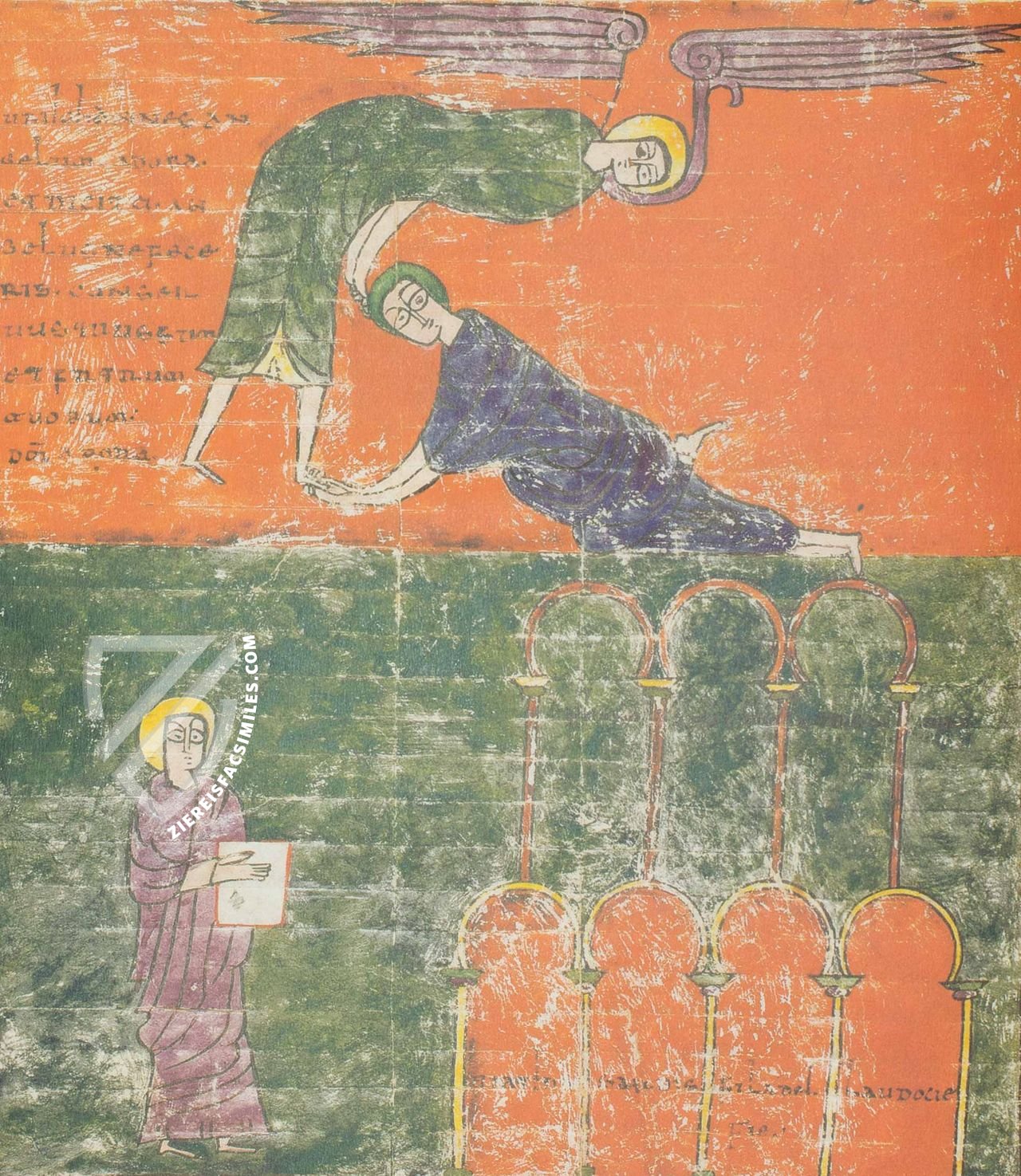
Beatus of Liébana - Codex Urgellensis
The Woman and the Dragon
The Woman of the Apocalypse is one of the most prominent figures of John’s Revelation and is widely considered to be either the Virgin Mary or God’s people as a whole. Depicted in this double-page miniature with a striped background typical for Beatus manuscripts, she appears in the top left clothed in the sun, the moon at her feet, and crowned with twelve stars.
The red, seven-headed dragon wants to devour her child, who is snatched up and saved by God, seen in the upper right corner. This provokes the War in Heaven and spear-wielding angels commanded by the Archangel Michael descend upon the dragon, who is defeated and cast down along with his fallen angels – depicted as being pink and naked, having been stripped of their fair hue.

#1 Beato de la Seo de Urgell
Languages: German, Spanish
(3,000€ - 7,000€)
- Treatises / Secular Books
- Apocalypses / Beatus
- Astronomy / Astrology
- Bestiaries
- Bibles / Gospels
- Chronicles / History / Law
- Geography / Maps
- Saints' Lives
- Islam / Oriental
- Judaism / Hebrew
- Single Leaf Collections
- Leonardo da Vinci
- Literature / Poetry
- Liturgical Manuscripts
- Medicine / Botany / Alchemy
- Music
- Mythology / Prophecies
- Psalters
- Other Religious Books
- Games / Hunting
- Private Devotion Books
- Other Genres
- Afghanistan
- Armenia
- Austria
- Belgium
- Belize
- Bosnia and Herzegovina
- China
- Colombia
- Costa Rica
- Croatia
- Cyprus
- Czech Republic
- Denmark
- Egypt
- El Salvador
- Ethiopia
- France
- Germany
- Greece
- Guatemala
- Honduras
- Hungary
- India
- Iran
- Iraq
- Israel
- Italy
- Japan
- Jordan
- Kazakhstan
- Kyrgyzstan
- Lebanon
- Liechtenstein
- Luxembourg
- Mexico
- Morocco
- Netherlands
- Palestine
- Panama
- Peru
- Poland
- Portugal
- Romania
- Russia
- Serbia
- Spain
- Sri Lanka
- Sweden
- Switzerland
- Syria
- Tajikistan
- Turkey
- Turkmenistan
- Ukraine
- United Kingdom
- United States
- Uzbekistan
- Vatican City
- A. Oosthoek, van Holkema & Warendorf
- Aboca Museum
- Ajuntament de Valencia
- Akademie Verlag
- Akademische Druck- u. Verlagsanstalt (ADEVA)
- Aldo Ausilio Editore - Bottega d’Erasmo
- Alecto Historical Editions
- Alkuin Verlag
- Almqvist & Wiksell
- Amilcare Pizzi
- Andreas & Andreas Verlagsbuchhandlung
- Archa 90
- Archiv Verlag
- Archivi Edizioni
- Arnold Verlag
- ARS
- Ars Magna
- ArtCodex
- AyN Ediciones
- Azimuth Editions
- Badenia Verlag
- Bärenreiter-Verlag
- Belser Verlag
- Belser Verlag / WK Wertkontor
- Benziger Verlag
- Bernardinum Wydawnictwo
- BiblioGemma
- Biblioteca Apostolica Vaticana (Vaticanstadt, Vaticanstadt)
- Bibliotheca Palatina Faksimile Verlag
- Bibliotheca Rara
- Boydell & Brewer
- Bramante Edizioni
- Bredius Genootschap
- Brepols Publishers
- British Library
- C. Weckesser
- Caixa Catalunya
- Canesi
- CAPSA, Ars Scriptoria
- Caratzas Brothers, Publishers
- Carus Verlag
- Casamassima Libri
- Centrum Cartographie Verlag GmbH
- Chavane Verlag
- Christian Brandstätter Verlag
- Circulo Cientifico
- Club Bibliófilo Versol
- Club du Livre
- CM Editores
- Collegium Graphicum
- Collezione Apocrifa Da Vinci
- Comissão Nacional para as Comemorações dos Descobrimentos Portugueses
- Coron Verlag
- Corvina
- CTHS
- D. S. Brewer
- Damon
- De Agostini/UTET
- De Nederlandsche Boekhandel
- De Schutter
- Deuschle & Stemmle
- Deutscher Verlag für Kunstwissenschaft
- DIAMM
- Droz
- E. Schreiber Graphische Kunstanstalten
- Ediciones Boreal
- Ediciones Grial
- Ediclube
- Edições Inapa
- Edilan
- Editalia
- Edition Deuschle
- Edition Georg Popp
- Edition Leipzig
- Edition Libri Illustri
- Editiones Reales Sitios S. L.
- Éditions de l'Oiseau Lyre
- Editions Medicina Rara
- Editorial Casariego
- Editorial Mintzoa
- Editrice Antenore
- Editrice Velar
- Edizioni Edison
- Egeria, S.L.
- Eikon Editores
- Electa
- Emery Walker Limited
- Enciclopèdia Catalana
- Eos-Verlag
- Ephesus Publishing
- Ernst Battenberg
- Eugrammia Press
- Extraordinary Editions
- Fackelverlag
- Facsimila Art & Edition
- Facsimile Editions Ltd.
- Facsimilia Art & Edition Ebert KG
- Faksimile Verlag
- Feuermann Verlag
- Folger Shakespeare Library
- Franco Cosimo Panini Editore
- Friedrich Wittig Verlag
- Fundación Hullera Vasco-Leonesa
- G. Braziller
- Gabriele Mazzotta Editore
- Gebr. Mann Verlag
- Gesellschaft für graphische Industrie
- Getty Research Institute
- Giovanni Domenico de Rossi
- Giunti Editore
- Graffiti
- Grafica European Center of Fine Arts
- Guido Pressler
- Guillermo Blazquez
- Gustav Kiepenheuer
- H. N. Abrams
- Harrassowitz
- Harvard University Press
- Helikon
- Hendrickson Publishers
- Henning Oppermann
- Herder Verlag
- Hes & De Graaf Publishers
- Hoepli
- Holbein-Verlag
- Houghton Library
- Hugo Schmidt Verlag
- Idion Verlag
- Il Bulino, edizioni d'arte
- ILte
- Imago
- Insel Verlag
- Insel-Verlag Anton Kippenberger
- Instituto de Estudios Altoaragoneses
- Instituto Nacional de Antropología e Historia
- Introligatornia Budnik Jerzy
- Istituto dell'Enciclopedia Italiana - Treccani
- Istituto Ellenico di Studi Bizantini e Postbizantini
- Istituto Geografico De Agostini
- Istituto Poligrafico e Zecca dello Stato
- Italarte Art Establishments
- Jan Thorbecke Verlag
- Johnson Reprint Corporation
- Josef Stocker
- Josef Stocker-Schmid
- Jugoslavija
- Karl W. Hiersemann
- Kasper Straube
- Kaydeda Ediciones
- Kindler Verlag / Coron Verlag
- Kodansha International Ltd.
- Konrad Kölbl Verlag
- Kurt Wolff Verlag
- La Liberia dello Stato
- La Linea Editrice
- La Meta Editore
- Lambert Schneider
- Landeskreditbank Baden-Württemberg
- Leo S. Olschki
- Les Incunables
- Liber Artis
- Library of Congress
- Libreria Musicale Italiana
- Lichtdruck
- Lito Immagine Editore
- Lumen Artis
- Lund Humphries
- M. Moleiro Editor
- Maison des Sciences de l'homme et de la société de Poitiers
- Manuscriptum
- Martinus Nijhoff
- Maruzen-Yushodo Co. Ltd.
- MASA
- Massada Publishers
- McGraw-Hill
- Metropolitan Museum of Art
- Militos
- Millennium Liber
- Müller & Schindler
- Nahar - Stavit
- Nahar and Steimatzky
- National Library of Wales
- Neri Pozza
- Nova Charta
- Oceanum Verlag
- Odeon
- Orbis Mediaevalis
- Orbis Pictus
- Österreichische Staatsdruckerei
- Oxford University Press
- Pageant Books
- Parzellers Buchverlag
- Patrimonio Ediciones
- Pattloch Verlag
- PIAF
- Pieper Verlag
- Plon-Nourrit et cie
- Poligrafiche Bolis
- Presses Universitaires de Strasbourg
- Prestel Verlag
- Princeton University Press
- Prisma Verlag
- Priuli & Verlucca, editori
- Pro Sport Verlag
- Propyläen Verlag
- Pytheas Books
- Quaternio Verlag Luzern
- Reales Sitios
- Recht-Verlag
- Reichert Verlag
- Reichsdruckerei
- Reprint Verlag
- Riehn & Reusch
- Roberto Vattori Editore
- Rosenkilde and Bagger
- Roxburghe Club
- Salerno Editrice
- Saltellus Press
- Sandoz
- Sarajevo Svjetlost
- Schöck ArtPrint Kft.
- Schulsinger Brothers
- Scolar Press
- Scrinium
- Scripta Maneant
- Scriptorium
- Shazar
- Siloé, arte y bibliofilia
- SISMEL - Edizioni del Galluzzo
- Sociedad Mexicana de Antropología
- Société des Bibliophiles & Iconophiles de Belgique
- Soncin Publishing
- Sorli Ediciones
- Stainer and Bell
- Studer
- Styria Verlag
- Sumptibus Pragopress
- Szegedi Tudomànyegyetem
- Taberna Libraria
- Tarshish Books
- Taschen
- Tempus Libri
- Testimonio Compañía Editorial
- Thames and Hudson
- The Clear Vue Publishing Partnership Limited
- The Facsimile Codex
- The Folio Society
- The Marquess of Normanby
- The Richard III and Yorkist History Trust
- Tip.Le.Co
- TouchArt
- TREC Publishing House
- TRI Publishing Co.
- Trident Editore
- Tuliba Collection
- Typis Regiae Officinae Polygraphicae
- Union Verlag Berlin
- Universidad de Granada
- University of California Press
- University of Chicago Press
- Urs Graf
- Vallecchi
- Van Wijnen
- VCH, Acta Humaniora
- VDI Verlag
- VEB Deutscher Verlag für Musik
- Verlag Anton Pustet / Andreas Verlag
- Verlag Bibliophile Drucke Josef Stocker
- Verlag der Münchner Drucke
- Verlag für Regionalgeschichte
- Verlag Styria
- Vicent Garcia Editores
- W. Turnowski Ltd.
- W. Turnowsky
- Waanders Printers
- Wiener Mechitharisten-Congregation (Wien, Österreich)
- Wissenschaftliche Buchgesellschaft
- Wissenschaftliche Verlagsgesellschaft
- Wydawnictwo Dolnoslaskie
- Xuntanza Editorial
- Zakład Narodowy
- Zollikofer AG




